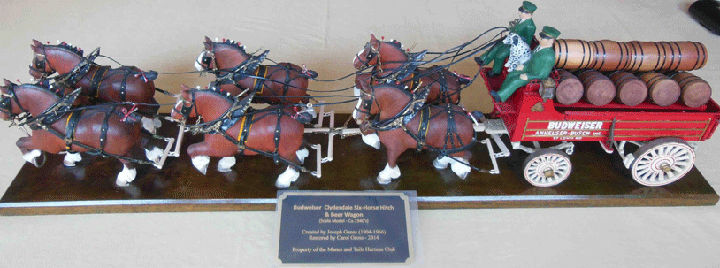Steps
In the Budweiser Clydesdale Hitch Model Restoration
1.
Refinishing the wooden base under the hitch.
The front portion of the base was sanded, and
several stains were tested to try to match the back portion of the board,
without removing the horses and wagon, which were bolted to the board. Multiple stains were attempted,
followed by sanding, until a color approaching the back of the board was
reached. Several coats of varnish
were then applied, with light sanding between each coat.
2.
Painting the horses
The lead horses had almost no stain/paint left on
them. The colors of acrylic paint used in the restoration of the horses
included: burnt sienna, burnt
umber, raw umber, bronze yellow, black and titanium white. They were diluted with water and
applied as a wash, until the desired colors were attained that came closest to
the original colors of the swing and wheel teams. The swing and wheel teams were then painted. A matte varnish was then used to
preserve the paint.
3.
Painting the driver and assistant
An acrylic wash containing
green, blue and yellow was used to try to match the color of the uniforms
pictured in the Budweiser Clydesdale photos, followed with a matte varnish.
4.
Painting the beer wagon, polls and horse collars
Rust-Oleum, oil-based gloss black was used for
the horse collars, gloss sunrise red with a little black was used for touching
up the wagon, a mixture of gloss almond, red and white were used for touching
up the poles, undercarriage of the wagon and the lettering.
5. Horse shoes
Three hooves were missing horseshoes. Aluminum craft wire (16-gauge, silver -
4mm wide), was cut down the center and bent laterally into a horseshoe-shape,
then glued to the bottom of the hooves that were missing shoes.
6.
Harness repair and reins
The tugs, parts of the
bridles, and one strap of over the saddle were originally made with a good-quality
leather, and were still holding together. These pieces were preserved and leather conditioner was applied to try
to moisturize the leather. Most
harness parts that needed replacing were cut from lambskin, glove leather. Leather glue was used to attach leather
harness parts together.
7. Back pads
The original scale model
harness had gold felt under the back pads to represent the brass on the back pads
of the authentic harness. Water
damage had caused shrinking and discoloration of the felt. All of the felt and leather
back pads were replaced, except for the back pad adjustment straps that were
made of a different type of leather and had not deteriorated.
8. Reins
Reins were made from 3/32 inch
lace leather from Tandy Leather Factory.
Gold Buckles from Rio Rondo
Enterprises were used on the reins. Leather glue was used to attach rein leather together, but the rein
leather did not hold a good bond, so small strips of black duck tape were used
to keep the leather from separating.
9. Brass
Original brass nails, brads
and hames were very tarnished, and required polishing. Brass polish (Braso), and sanding using
fine sand paper and a Dremel tool with a sanding attachment were used. Some brads/studs from the original
harness could not be reused, or were missing, so these were replaced. Suitable
brass brads and mini-brads and rings were found in the jewelry section of Michaels
and Jo-Ann Fabrics.
Heavy-duty, gold foil was cut
into thin strips and used to represent some harness buckles. The foil was used to replicate the
brass wire or sheeting used on the original harness, that could not be reused.
10. Brass
trim on beer wagon
Brass trim on side-panels of wagon was cut from 3/32”
square brass bars to replace the original aluminum horizontal and vertical
bars. The trim was attached by
glue that would bond metal and wood. Brass bars were purchased from Hub Hobby, Little Canada, MN.
11. Barrels
Wooden barrels were made on a lathe from a maple dowel. Barrels were stained with a golden oak stain followed with a coat of polyurathane. Barrel bilge
hoops were made using black plastic jewelry lacing, and attched with a glue that would bond plastic to wood. Barrels are 2” high and 1 ¾” wide at the widest point and 1 5/8” at
the ends.
12. Barrel Rack
A rack to hold the barrels inside the
wagon bed was fashioned out of ¼” x ¼” x 36” hardwood
dowels. The rack was designed to
hold barrels at an angle, similar to the original Budweiser hitch photo. The rack holds 5 barrels on each side.
13.
Mane Rosettes and Tail Ribbons
Mane rosettes
of the authentic hitch, were represented by painted knob-shaped pins. These were repainted with red or white
Rust-Oleum paint. Tail bows were
made from red and white ribbons attached with a transparent elastic thread.
Resources For Supplies Used In The Hitch Restoration
1.
JoAnn Fabrics - jewelry making materials and tools – chains, beads, clasps
2.
Michaels – round and flat aluminum wire,
rings, brads, acrylic paints, artist varnish
3.
Hub Hobby Center – Roseville, MN - brass strips
4.
Tandy Leather – Roseville, MN – glove leather,
jewelry leather, leather glue, studs
5.
Menards and local hardware stores – Rust-Oleum
paints, stains, wood varnish, brass polish, sand paper
6.
Rio Rondo Enterprises (KS)– miniature items
for model horses (buckles, bits, horse shoes, hardware, etc.)
Resources
Used For Historic Significance and Restoration Details (generous loan from Floyd Nelson)
1. All the King’s Horses, The Story of the Budweiser
Clydesdales
Photos by Alix Coleman
Text by Steven D. Price
The Viking Press, New York (A
Studio book)
Copyright 1983, 3rd printing November
1986
ISBN 0-670-22588-6
2. Work Horse Handbook
By Lynn R. Miller
Mill Press, Inc., New York
Copyright ã1981
ISBN 0-9607268-0-2
Video
Resources On The History Of The American Beer Industry
1.
Empires of Industry (1999), Part 2: Beer Brewers,
Narrated by Dan Chandler
2.
American Eats: Beer (2006), Narrated by Jeremy
Schwartz

